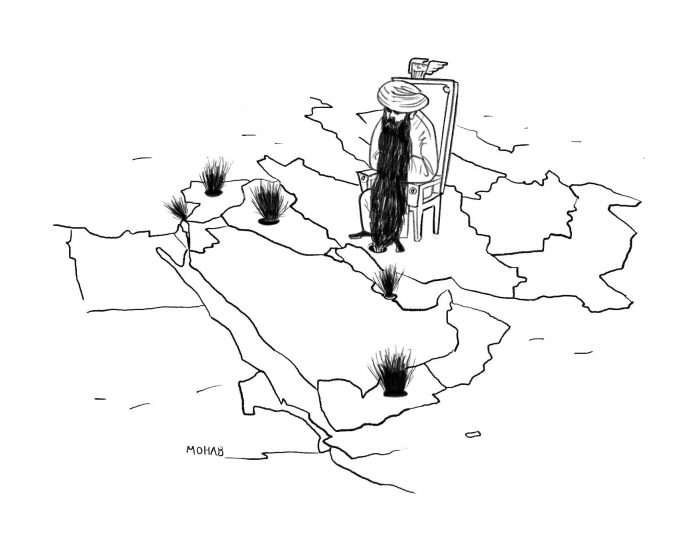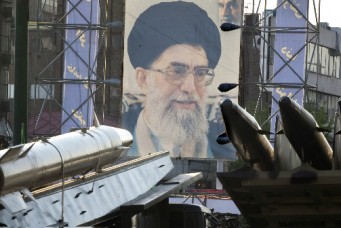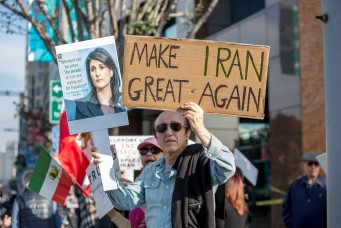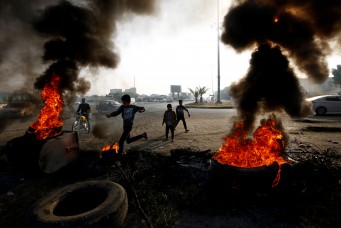Swamped in a Triple Crisis
Following the 2017–18 uprising, Iran is sick, stuck in three endemic crises with a foreign policy unlikely to alleviate what ails it

The 2017–18 uprising has heralded a new chapter in the history of the Islamic Republic that, in its fortieth year, is mired in acute and seemingly insurmountable domestic and foreign policy challenges with no end in sight. On the domestic front, since a nationwide wave of protests shook the country between late December 2017 and early January 2018, demonstrations by various groups, including laborers and women, have continued.
In fact, the uprising constituted the most radical political protests the Islamic Republic has seen since its inception. The protests had an unprecedented geographical spread, and were driven by the lower classes—conventionally considered to be part of the regime’s social base, or at least loyal to it. Initiated by powerful hard-line opponents of the Hassan Rouhani administration in Mashhad, the demonstrations which started in protest of Rouhani’s economic performance immediately spiraled out of control, spreading to all corners of the country and targeting the entire elite as well as the ideological pillars of the Islamic Republic.
The demonstrations ended after about ten days due to a combination of repression by security forces and the absence of important middle-class participation. However, the short-lived revolt sent shockwaves across the country’s establishment about the sheer depth of people’s dissatisfaction with main factions of the regime, the so-called moderates as well as the hard-liners.
While some senior security establishment figures concluded the country’s greatest national security threat would emanate not from outside but from within, Iranian social scientists agreed that the next explosion of popular anger would surely come in a more forceful fashion given the persistence of factors that spawned the uprising in the first place.
The Triple Crisis
The Islamic Republic is facing three crises—political, socioeconomic, and ecological—each dramatic in its own right. Politically, the state, characterized by the superiority of theocratic over semi-republican institutions, has shown itself immune to meaningful reform. The protests, meanwhile, showed the rejection of the Islamic Republic’s factionalism, which had hitherto offered the Iranian people a choice between the lesser evil (usually, a moderate establishment figure) and the larger evil (usually, the hard-liners) at presidential elections.
Socioeconomically, the country faces similar troubles to other nations in the Middle East region affected by the Arab Spring. These include high unemployment, especially among the youth and women. A new class, termed the “middle-class poor,” has emerged as a result of the neoliberal shift in economic policies since the 1990s. They formed the social base of the protests, defined as those with middle-class qualifications and aspirations who now find themselves in a socioeconomically precarious position.
Ecologically, desertification and water shortages have already started to undermine the livelihoods of tens of millions, leading to uncompromising anger against authorities’ mismanagement and neglect, and state repression. If the environmental crises are not solved, in a decade’s time, half of Iran’s provinces are likely to become uninhabitable. Also, in three decades’ time, the entire country may turn into a desert. The recent catastrophic floods starting in mid-March and lasting until April 2019 in over two-thirds of the country’s provinces are a case in point. More devastating than the notorious earthquakes plaguing the country, the reasons for the floods—which caused massive devastation estimated at around $3 billion—were primarily man-made and a result of mismanagement. Therefore, immense anger was directed at the authorities’ shortcomings and negligence. Ironically, environmental activists have been viewed as a national security threat as their work uncovers the complicity of the rulers in the ecological catastrophe.
“Rally-Round-the-Flag” Effect Tapers Off
Faced with internal dissent since its inception, the Islamic Republic has learned to master the art of using and abusing foreign crises to consolidate power at home. The longevity of the Islamic Republic can be traced back to a combination of internal and external factors, which are at times interrelated. Since the 1979 revolution that brought them to power, Iran’s rulers have willfully mastered the art of employing external crises to create a rally-round-the-flag effect at home, based on a narrative in which Iran is the innocent victim of unjustified and abusive imperialist powers—which may at times have had a kernel of truth.
The regime has used this technique to disavow and crack down on internal dissenters, portraying them as stooges of malign outside forces. Next to the anti-imperial zeitgeist that generated the revolution, it has been foremost nationalistic sentiments that the Islamist rulers have tried to exploit.
Moreover, a political and economic oligarchy has limited spaces for other sectors of society to meaningfully challenge the status quo, while the political system’s sophisticated authoritarianism has blocked the way for serious reform. The regime has not shied away from the crises that created it in the first place, such as the 444-day-long occupation of the U.S. Embassy within the first year of the revolution. To consolidate its power against rivals, Ayatollah Khomeini chose not to seize the opportunity to end the devastating war with Iraq in 1982. Add to that the permanent rhetorical attacks against the “Great Satan” (the United States) and the “Little Satan” (Israel), which has sustained the bitter antagonism with those states.
However, today the effectiveness of such rhetoric has lost much appeal among ordinary Iranians who have—almost on a daily basis for four decades—heard these narratives of blaming outsiders for internal problems. The uprising turned much of the regime’s rhetoric about outsiders on its head in one famed chant heard across the country: Doshman-e mâ haminjâst, hamash migan Âmrikâst (Our enemy is right at home, they always say it’s America).
Strategic Loneliness and Foreign Militias on Iranian Soil
On the external front, Iran still suffers from “strategic loneliness,” which dates back to the Islamist takeover in 1979, and which is both externally and self-imposed. On one hand, Iran’s post-revolutionary foreign policy has alienated many of its neighbors, fearful of its “export of the revolution” doctrine, while its independent character has placed it at odds with the United States—a superpower largely intolerant of independent actors in strategically vital world regions. On the other, its isolation is self-imposed, given the Islamic Republic’s uncompromising revolutionary rhetoric directed against “the West” and some neighboring states. As stated above, such enmity has been routinely evoked in an effort to consolidate power domestically. This perennial hostility toward the international system’s most powerful state has overshadowed, and will continue to do so, Iran’s relations with other powers such as Europe, its pro-Western neighbors in the Middle East, and non-Western great powers (Russia, China, and India) whose relations with Washington supersede those with Tehran.
This situation has sustained a massive conventional military asymmetry to the detriment of Iran, which has been deprived of purchasing Western high-tech weaponry as a result of U.S.-led sanctions. Surrounded by adversarial countries with U.S. military bases, as well as Israel and the Gulf Cooperation Council’s huge arsenals, the Islamic Republic has relied on means of deterrence that include asymmetric warfare, a regional network of mostly non-state actors, and its ballistic missile program. It has also depended on soft power in the form of anti-imperialist, anti-Zionist, and revolutionary rhetoric that has found great appeal among the region’s populace, whose own leaders have mostly remained silent regarding U.S. or Israeli foreign policies. However, this soft power on the “Arab street” has massively lost its appeal after Tehran supported Syria’s Bashar Al-Assad regime during the Arab Spring. Despite occasional efforts at détente, the Islamic Republic remains far from bridging those antagonisms, not least because it still considers them key to the regime’s ideological raison d’être and hence survival.
As such, Iran’s regional policies not only aim to defend the country’s sovereignty and national security, but are also connected to domestic power considerations. A key example here is the role played by the Islamic Revolutionary Guards Corps (IRGC) and its foreign-operations arm, the Quds Force, that is active in Iran’s regional policies (militarily, ideologically, and economically), which supports its domestic standing as a security and political player and broker.
The IRGC has trained a number of foreign militias—a kind of “Shia international”—especially for its involvement in Syria and Iraq. While these international militias are used outside of Iran, there is growing concern that they might be deployed inside the country to quell growing popular dissent. During the 2019 floods for example, the deployment of hundreds of Popular Mobilization Forces (PMF) from Iraq, Afghan Fatemiyoun Division from Syria, and Lebanese Hezbollah, for relief efforts, caused some public outcry.
It was claimed that calling upon foreign militias instead of Iran’s own hundreds of thousands of military personnel was also to normalize their presence in Iran. During the 2009 Green Movement protests, some Lebanese Hezbollah forces were deployed to suppress political protests, as an ostensible effort to avoid solidarity with protesters.
A Janus-Faced Foreign Policy
The bipolar power structure in the Islamic Republic also translates into its foreign policy, sometimes referred to as Janus-faced: on the one hand, the foreign ministry and the administration are involved in foreign affairs, and on the other, the Supreme Leader’s office (a quasi-parallel government) and the IRGC are also active in foreign affairs. Despite occasional confusion as to who calls the shots in Iran’s foreign policy, it would be safe to assume that it is the latter group—the IRGC and the Supreme Leader’s office—which gives the key directives, especially in regional affairs.
However, Iranian foreign policymaking also involves elite consensus. Or as Suzanne Maloney of the Brookings Institution succinctly puts it, “Iran’s approach to the world has always been an ensemble performance, not a solo act, and the conductor’s baton remains firmly in Khamenei’s paranoid grip.” That the right hand knows what the left hand does can be seen in the composition of the Supreme National Security Council, which makes strategic decisions on security and defense policy based on consensus, and assembles figures from both camps.
In this constellation, there is a strong element of complementarity and division of labor between those two wings. As Karim Sadjadpour, Iran expert, has aptly put it: “[Qasem] Soleimani [the commander of the Quds Force] serves as Khamenei’s sword, projecting Iranian hard power in the Middle East’s most violent conflicts. [Mohammad Javad] Zarif [the Iranian foreign minister], in contrast, serves as Khamenei’s shield, using his diplomatic talents to block Western economic and political pressure and counter pervasive ‘Iranophobia.’ […] Soleimani deals with foreign militias, Zarif with foreign ministries.”
A Precarious Present and an Uncertain Future
There is no sign that the Islamic Republic can meaningfully address any of the three crises which fueled the 2017–18 uprising. A year after the mass demonstrations, the country still faces protests, accompanied by a worsening economic situation and the re-imposition of U.S. extraterritorial sanctions following President Donald Trump’s unilateral withdrawal from the Iran nuclear agreement. Interviewed by the IRGC’s Tasnim News Agency earlier this year, sociologist Mohammad-Reza Tajik—a former advisor to reformist president Mohammad Khatami and a strategist who served as vice minister of the intelligence ministry in charge of psychological warfare—provided an alarming assessment of Iran today. Tajik said, “Iranian society finds itself in decay, in a situation where the past is dying and the future cannot emerge, nor the ability to reform.”
On the societal level, Iran’s civil society remains relatively weak, with its constituent parts—the women’s, labor, and student movements—facing repression, and so far lacking the ability to push for an intersectional and cross-class alliance that could truly challenge state authority. At the state level, the post-Khamenei era is on the horizon, with the possibility that rather than a successor as supreme leader, a leadership council might replace him. This could play out in multiple ways, but the most likely feature seems to be a more prominent role for the IRGC, which could extend its dominance beyond the security, economic, intelligence, and judicial realms into the political one.
Given the depth and size of its internal and external challenges, the Islamic Republic is in regime-survival mode. To avoid a full-scale social explosion, it might opt for a relative easing of public morality, while promoting a nationalist discourse over a religious one. In regional policies, dwindling resources and increasing domestic criticism might push it to be more cautious, while a threat to regime survival from within may encourage it to seek foreign adventurism to unite people at home. However, this would be a risky endeavor as many of those post-revolutionary rhetorical devices have lost their appeal.
Internationally, U.S. sanctions are likely to continue to deprive Iran of much-needed income and foreign exchange from oil sales, while its international relations will suffer in the shadow of U.S. enmity. Given this position of weakness, Tehran will continue to grant concessions to non-Western great powers in exchange for their political support. In other words, after a tumultuous past four decades, the Islamic Republic now stands at the crossroads between a precarious present and an uncertain future. This new chapter in the history of the Islamic Republic was heralded by the 2017–18 rebellion and is likely to remain characterized by constant turmoil, as the triple crises of environmental destruction, economic hardship, and political uncertainty persist and even deepen, while the state’s responses remain insufficient.
Dr. Ali Fathollah-Nejad, a German–Iranian political scientist, is Iran expert with the American University of Beirut’s Issam Fares Institute for Public Policy and International Affairs (AUB-IFI), where he publishes a report entitled Iran in Focus. He is also the author of the much-acclaimed book Iran in an Emerging New World Order (2021). Twitter: @AFathollahNejad
Read More



